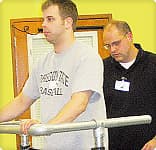



- Viagra
- Sildenafil Citrate (TP)
- Sildenafil Citrate TEVA
- Tadalafil TEVA
- Tadalafil ACCORD
- Tadalafil DAILY
- Vardenafil TEVA
- Vardenafil ZYDUS
- Sildenafil Citrate (GS)
- Cialis
|
Spine Injury Breakthrough: Paralyzed Man Stands, Moves
2011-05-31
|
Spine Injury Breakthrough: Paralyzed Man Stands, Moves
 May 19, 2011 - Rob Summers can't walk -- yet. But he can do something no other person paralyzed with a devastating spinal cord injury ever has done: He can stand up from his wheelchair when he wants to.
May 19, 2011 - Rob Summers can't walk -- yet. But he can do something no other person paralyzed with a devastating spinal cord injury ever has done: He can stand up from his wheelchair when he wants to.
"Being able to stand for first time was both emotional and exciting. After years of seeing no gains or recovered function, I was able to see my hard work pay off. It was as rewarding as anything I have ever done in my life," Summers said at a news teleconference.
He does it with the help of a pacemaker-like device that sends a gentle electric current through 16 electrodes implanted in his spine. The device doesn't make his muscles move -- he does. This "epidural stimulation" excites the neurons in his spine, allowing them to receive and react to sensory information from his legs.
These results are being hailed as "unprecedented in spinal cord injury medicine," a "breakthrough," and as "going to make a major impact" by spine-injury experts not directly linked to the study by Susan Harkema, PhD, of the University of Louisville, Ky., and colleagues.
"What we have found here is a new set of mechanisms that have never been taken advantage of in a therapeutic way," Harkema said at a news conference held to announce the findings. "It opens a whole new set of possibilities for patients, not just those recently injured but those who have been injured for months and years."
Hard Work Leads to Success
The breakthrough did not happen overnight. It's the result of more than 30 years of animal research by a number of scientists. Prominent among them is Harkema's mentor and study partner, University of California, Los Angeles researcher V. Reggie Edgerton, PhD.
"When Rob regained voluntary control of his leg, I was afraid to believe it when I saw it," Edgerton said at the news conference. "What nobody has ever demonstrated is that epidural stimulation at modest levels enables an individual to have conscious control of body motion. Someone with paralysis for several years can now control his movement. This has never been done before."
Summers was a 20-year old pitcher for Oregon State's championship team. Late one night in July 2006, he was taking his gym bag out of his car when another car jumped the curb and knocked his legs out from under him. He woke up unable to move his legs or trunk, or to control his anal sphincter or bladder.
Eventually he found his way to TIRR Research Center in Houston, the same rehab center now treating Rep. Gabrielle Giffords. Harkema, at TIRR for a visit, met Summers and invited him to the Kentucky Spinal Cord Injury Research Center, where she is director.
Summers became the first of a planned five patients to receive the epidural stimulation device, originally designed and FDA-approved for pain relief. California Institute of Technology engineer Joel Burdick, PhD, adapted the device for spinal cord treatment. Jonathan Hodes, MD, chair of the University of Louisville department of neurosurgery, implanted the device into Summers' spine.





